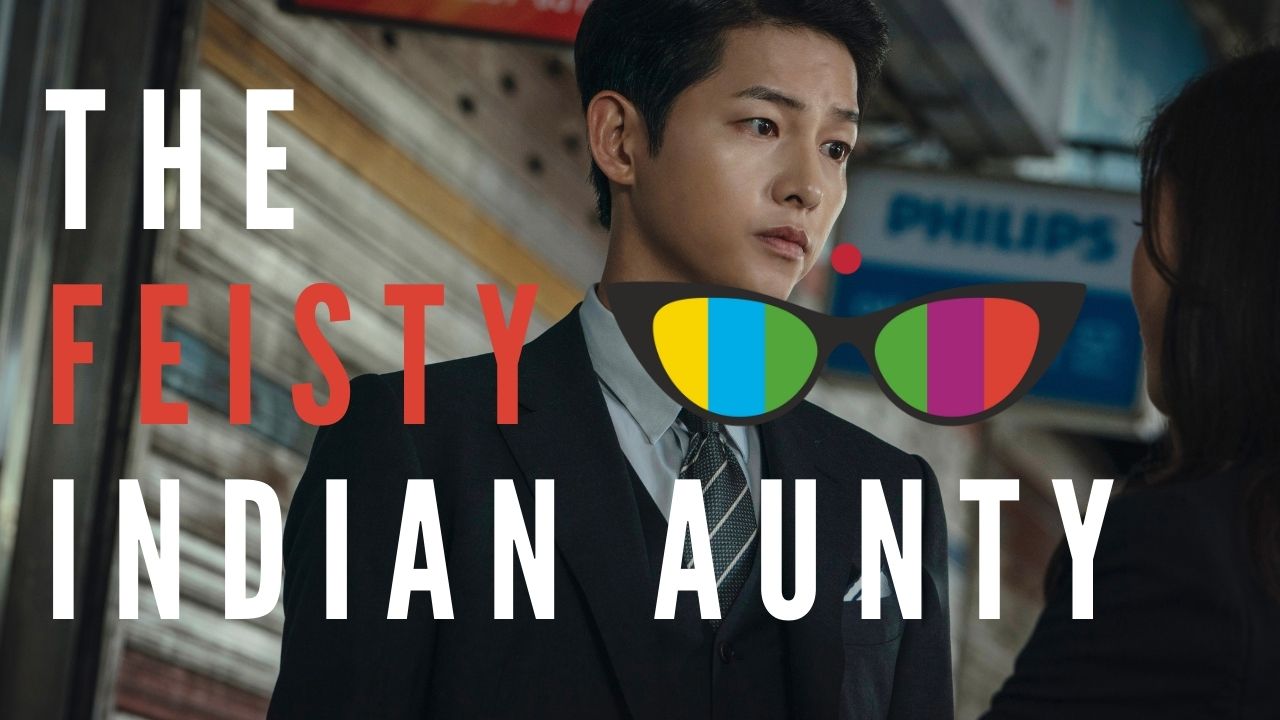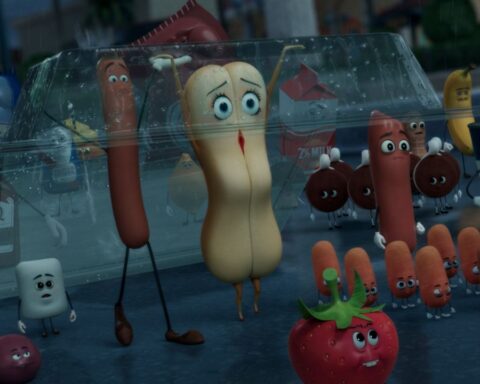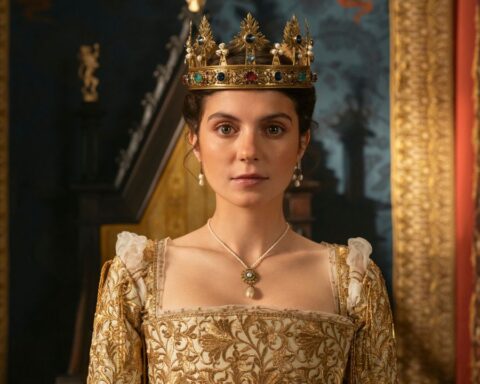The sixth episode of The Nevers first season aired earlier this week, drawing to a close what HBO calls “Part One” of the series and putting a whole new spin on the show so far. The episode, “True,” revealed that The Nevers has ambitions far greater than being just a Victorian spin on the X-men (or X-Women) and plans to tell a much bigger story, on a far bigger canvas than we could have possibly imagined.
So what happened?
Read on for our recap of the episode, what we think was going on, our reactions to it, and what we reckon it means for the future of The Nevers.
THIS ARTICLE CONTAINS SPOILERS FOR SEASON 1 OF THE NEVERS
CONSIDER YOURSELF WARNED!
What the Hell Just Happened?

A world away from the Victorian London setting of the rest of the series, Episode 6 of The Nevers opens with the title, “Chapter 1: Stripe.” In a futuristic hellscape, a team of soldiers from the Planetary Defence Coalition (PDC) take over a SciPost (Science Outpost) to keep it from falling into the hands of the FreeLife Army. Everyone needs breathing masks outside and, from the soldiers comments, it seems unmercifully cold as well. Nothing about this dystopian future is spelled out in on-screen text but there is plenty we can infer.
For some reason, names are very important in this dark future, with the PDC team members only referring to each other by their rank/job titles and FreeLife propaganda blaring out “give up your names!” over the battlefield.
A “Crescent” seems to be some kind of “commander,” with a “Stripe” also being a well regarded rank. Regular soldiers are referred to as “Boots,” with first boot, second boot, etc. being used to differentiate between soldiers of the same rank. Other specialized roles like medic and computer expert have their own designations, “Knitter” and “Byner” respectively. The only person who shares their actual name in the SciPost is Major Joseph Willing Greenbone, a FreeLife soldier captured by the PDC troops.
The Last Galanthi

As the PDC troops explore the SciPost, it’s revealed that it may house the last “Galanthi,” a term that Amalia True and Penance have been throwing with no explanation in recent episodes. From discussions between the “Stripe” from another Pride (regiment), played by the awesome Claudia Black, and the Pride’s Knitter (Ellora Torchia), it’s gradually revealed that the Galanthi were an alien race that came to a dying Earth to help save it… apparently. Not everyone took their offer at face value however, with the PDC fighting on the side of the Galanthi and the FreeLife forces fighting to eradicate them.
Why would anyone reject such help? Well, despite the planet being in bad shape before they arrived, the Galanthi dropped mind altering “spores” when they appeared. The Spores are some kind of alien tech that alters humans to help them understand Galanthi technology and language, which might even make people affected by them more sympathetic towards the Galanthi. While it’s not explicitly stated in the episode, we can assume the FreeLife forces didn’t look kindly on such intervention and have been exterminating the Galanthi as they find them.
While investigating the SciPost, the Stripe and the Knitter find Victorian artefacts and discuss other massive Galanthi projects such as tectonic stabilizers and water purification, implying that the planet is even more messed up than it appeared. The squad eventually finds the Galanthi, who had been tortured by FreeLife forces. They had killed the scientists the Galanthi had been working with, and whom it had bonded with empathically.
As the Major gets free and some of the PDC Pride turn on each other, the Byner accidentally activates the power to the project the Galanthi was working on.
What Was the Galanthi Planning?

It appears the Glanathi has had enough and is leaving. Back through a portal in space, like the ones it, and the other 20 or so Galanthi, used to first arrive on Earth.
With most of the PDC Pride dead or dying, including the Knitter, the Byner, the Boots, and the FreeLife Major, the Stripe, feeling the futility of it all, grabs some bottles marked “hazardous” and retreats to the garden the Pride had discovered earlier. With even humanity’s supposed saviour abandoning them, the Stripe commits suicide by drinking from the bottles, as the Galanthi, in non-corporeal form, leaves the SciPost. As it passes through the Stripe and the surrounding matter to return to space, its ethereal tendrils seem to embrace the Stripe as she dies.
And that’s where things get really interesting.
Who Is Molly “Amalia” True?

Chapter 2 of the episode, titled “Molly,” follows the tragic life of Molly ”Amalia“ True as she struggles to survive in Victorian London. This is not the driven, ass-kicking Amalia we’ve come to know throughout the series. For one thing, her accent is very different and she lives a normal, simple life. She spends her days making and delivering cakes, marrying a brutish husband, suffering one indignity after another, until she finally decides to end it all by jumping into the Thames. And she just so happens to do it on the same day as the Galanthi arrived in London and the touched received their powers.
Rather than abandoning Earth, the Galanthi used the portal to travel through time, back to the Victoria era. To a time when the damage to the Earth’s environment wasn’t so severe, or perhaps to a time when resistance to it wouldn’t be so strong. It didn’t come alone.
Chapter 3: The Madwoman in the Thames

The Galanthi had somehow brought the Stripe’s consciousness with them, depositing her in the now handily vacant mind/body of Molly True. This chapter follows Stripe/Amalia as she adapts to Victorian London and her new, younger, smaller, weaker body, after she initially assumes she’s in was some kind of simulation intended to pry information out of her.
At the sanatorium where she’s incarcerated, she first meets Dr. Horatio Cousens, experiences her first flash forward to the “near” future, and also becomes friends with Sarah, the woman who will eventually become Maladie.
Maladie: Origins

How does Sarah go from the sweet woman who thinks she saw God the day the Galanthi arrived, to the psychopathic, violent Maladie? Blame Amalia! When the unscrupulous Dr. Edmund Hague (Denis O’Hare) comes calling, looking for Touched to “aid” him in his research, she points him in Sarah’s direction to divert his focus from her. Unfortunately this leads to the torture Maladie described to Amalia in Episode 2, “Exposure.”
The final chapter of the episode, “True,” outlines what happened when Amalia and her team of Touched “orphans” tried to reach the Galanthi while Penance was attempting to rescue Maladie from hanging in the previous episode.
After fighting their way through the tunnels under London, Amalia confronts the sleeping Galanthi demanding to know why was she brought here, why was she put in this body, and what is the plan?
In response, the Galanthi seems to present her with a vision.
What was in Amalia’s Vision?

As Amalia falls off the gantry below the resting Galanthi she see flashes from both Zephyr and Molly’s life. Does this mean that she now has some of Molly’s memories to help her fit in Victorian London?
She also sees:
- An irate Begger King asking her if she wants a war.
- Maladie looking sad/normal.
- “Augie” Bidlow looking sad.
- Someone saying: “You think you’re the only one who hitched a ride?”
- A drowning man, his face obscured. (Could this be someone else from the future, who has taken residence in another person who died as the Galanthi arrived?)
- A conversation between Amalia and Penance, presumably taking place just after Amalia informed her of the existence of the Galanthi.
- A group of Dr Hague’s mutilated assitants rushing the cave.
- Lord Massen firing a shot gun directly at the camera.
- Myrtle, standing against a Starfield, apparently having mastered her turn saying in English, “Oh Amalia. This is a long time from that little cave. This I will need you to forget.”
What is it Myrtle could want Amalia to forget?
The Nevers Part One Finale Reactions

Uma and Iain share their thoughts on the Part One Finale and what it might mean for the future of the series, especially now that series creator Joss Whedon has left the show.
Uma: The Nevers is completely insane. On The Goggler Podcast, we spoke about how “nothing was as it seems” in
“Victorian X-Men,” but I don’t think I was ready for Episode 6. I thought they would drag out a reveal of that scale over the course of the season. Teasing us. Torturing us. But nope. They put it all out there. Got it out of the way, so they can now move on to telling a much bigger story.
Iain: As surprising as the jump to a grimdark future was, with the lack of any explanation as to what’s going on and how it ties to the series so far… it was also at the same time an incredibly Whedon thing to do. He pulled almost the same trick on his previous Fox TV show, Dollhouse, which in its final episodes jumped from its present day setting (2008-2010) to the apocalyptic future of… *drum roll please*… 2020!
I’m glad The Nevers did this so early in the show as it paid off my questions as to why Amalia kept using modern terms for Penance’s inventions (like calling her “spectral-acle” an X-ray), and avoided the tropes of so many other split timeline shows. If this was on Netflix, we would have had the reveal in episode 9, by which point we would have all guessed the mystery and gotten bored waiting for it already. Here it was refreshing.
What A Twist

Uma: Agreed. On both of those points. Whedon does the same in Firefly too, where Mal’s world just exists. The prologue we see in Episode 1 of that series, never got addressed in any substantial way, but merely existed to outline both the trauma of civil war and the camaraderie that exists between Mal and Zoë.
Also, the writers were wise to pick up on the fact that the answers to all the questions we had, while important for context, would have gotten in the way of the narrative if withheld.
Iain: On Netflix, Firefly would have had flashbacks filling in more of that backstory every other episode, right?
Uma: PRECISELY! Or, in Episode 7…
Iain: … which would be told from the villains perspective. Although we may just get that down the road.
What I really enjoyed about the dark future on The Nevers was how sparsely it was sketched and yet how there was so much detail if you just looked hard enough. There lots of little details there for you. Nothing is too impenetrable but it leaves you with more questions. Also Claudia Black rules!
I’m a bit confused though. I went back and couldn’t quite find where Amalia started talking about the Galanthi?
This Wiki mentions Amalia telling the girls about it but I couldn’t find it in any of the episodes, and Penance calls it by name as they looked at the X-ray map of London at the beginning of Episode 5.
When Is a Plothole Not a Plothole?

Uma: Neither could I. I skimmed through the first four episodes of The Nevers again, but I think I need to do a proper rewatch. That said, I think it speaks to how little signposting there is in this series. There are hints and throwaway comments, but very little is out-and-out explained. Which is also what I loved most about that flashback (flashforward?) in the mid-season finale. It was a little confusing at first, but I did really appreciate how no time was wasted trying to explain to the audience what was going on. This was the reality for these characters after all, and God knows they wouldn’t take a moment, in the middle of a firefight, to explain what was going on to a teammate. I hate it when shows do that!
Iain: It was all explained in context. The “Crescent,” “Stripes,” “Knitter,” “Byner,” and “Boots” were all confusing at first but become clearer as the episode progressed. I’m not sure about the whole sacred name thing though. Why would the members of the PDC keep that a secret?
Also I assume the FreeLife army is opposed to the Galanthi because of those spores. They don’t like aliens messing with their minds? It’s a very cool sci-fi idea though.
Alien Nation

Uma: There’s a kernel of that idea in the classic TV series V. But there the aliens were actually evil and actually using us for food.
Iain: Well here’s the thing… what if the Galanthi are evil? From what little we’ve seen, they do look like Cthulu-esque monsters from beyond the stars! We only have Amalia and the PDC’s word to go on. What if the reason the Galanthi time travelled to Victorian London was that it would be easier to conquer humanity then!?
Uma: Good point. And that portentous tease at the end about how Amalia wasn’t the only one who was sent back could be a hint at some bigger conflict.
Iain: Do you think we’ve seen that person before? Do they even have to be an antagonist/villain? The voice shifts from male to female in Amalia’s vision so it’s not clear whether it is a man or a woman in the Victorian present, but in the vision there was a very quick shot of a man drowning with his face obscured. It was visually similar to what we’ve seen of Molly’s drowning and Zephyr’s arrival. He looked Blonde. Could it be Hugo Swan?
Uma: The obvious choice would be Lavinia. The heartbreaking choice would be Penance. I think Hugo would be the fun choice. That I would like to see.
Iain: It also all depends who came though. The obvious choice of antagonist from the future would be Major Joseph Willing Greenbone but could it have been one of the dying PDC Pride? Do you have to be dead, or dying, for the Galanthi to be able to swap out your consciousness?
Excelsior!

Uma: There is a real comic book sensibility to this series don’t you think? More so than in Buffy, or Angel, or Firefly. The way the story arcs seem to be structured. The mixing of genres. Even the large ensemble cast and how their stories intersect. It does make me wonder how accessible the show is to a mass audience. There is a LOT here to unravel.
Iain: Right! The plotting in The Nevers, which at first seemed to be just bad network TV plotting, perhaps caused by coronavirus related production woes, now reveals a much grander plot. I was mostly joking about that Netflix comparison above but, despite the superpowers storyline, the way they are telling this story does feel fresh.
Remember in Episode 1, we were introduced to Amalia and Penance on the go from the start. (Well, after that too long montage introducing us to EVERYONE IN LONDON!)
The reveal of the relationship between Maladie and Amalia felt rushed when it was first brought up, but it all makes sense when you go back and rewatch Episode 2. Of course they wouldn’t rehash their relationship in a warehouse where no one else was part of the conversation. They just talked about what mattered to them. The show puts a lot more trust in its audience than I ever assumed we would get from it.
Uma: It’s funny. What appeared as bad writing to us in the beginning turned out to be very good writing instead. That almost never happens. (See: Jupiter’s Legacy.)
This mid-season finale really was a showcase for Laura Donnelly though. She went from mild-mannered baker, to dispossessed wife, to madwoman, to American Gladiator, to Victorian vigilante, all in the course of an hour!
Canadian Gladiator

Iain: I think you mean Canadian Gladiator. Even that little detail was great. Amalia realising the distinction between Canada/America was imperceptible to the Imperial British, but also understanding that her accent was going to be a problem blending in.
Uma: I also loved that short My Fair Lady homage where she learns to perfect her English accent.
Iain: “Loud. Noisy girls” indeed.
So what do you think? Are the Galanthi friend or foe? After this, at the end of the full season it could be revealed as a blood sucking monster and I wouldn’t be surprised. We have very little to go on apart from Mary’s song and that future video recording of the cuddly “pet” Galanthi. After watching this episode, the show could go either way and I’d still be happy.
Uma: I think they might be both. I think there’s likely a bigger narrative involving the Galanthi as Vorlons. Some older race of aliens looking to groom us younger races and prepare us for universal exploration. (It could also be that I’ve been rewatching Babylon 5!)
Iain: Well… only 20 Galanthi ever came to Earth. FreeLife were worried they were scouts, but what if they were… survivors? Cue new big bad in Season 3, or based upon this show’s accelerated pace, Episode 12!
Remember, Remember

Iain: Away from the overarching plot, I do wonder what Maladie is going to be up to now that she’s dead in the public eye and no longer public enemy number one. There were a lot of shots of her looking forlorn but more “normal” in Amalia’s vision. She’s another piece of the puzzle I thought was just another lazy take on Drusilla from Buffy, but with the reveal of how she got that way (thanks Amalia) and that she’s the only one who remembers the Galanthi’s arrival (something the show didn’t quite make clear), I can’t imagine what she might be up to next.
Uma: I’m thinking that Season 2 of The Nevers might be set in that future where Amalia and Penance fail. The series has already demonstrated that it isn’t completely committed to its Victorian setting and this could be a very good thing. The way this mid-season finale wrapped also allows for new showrunner Philippa Goslett to carve out her own story from Whedon’s framework. Stopping it where they did, with Amalia revealing her true name, feels like the perfect place for a fresh start.
Iain: That would be very Dollhouse, but I wonder if they just used this jump forward to explain themselves and won’t return. I never thought we’d have to consider “The Philosophy of Time Travel of The Nevers,” but I’m assuming the Galanthi’s arrival in Victorian London would have disrupted that grimdark future. At least slightly? It all depends which model of time travel theory they are going with. Is all this predestined? Is Amalia now in an alternative timeline? Might the answer also explain the title of the show? If they succeed, and bring about a better future, will the battle hardened Stripe/Amalia never have existed?
My Name Is Zephyr Alexis Naveen

Uma: So, I’m really enjoying The Nevers so far. But I have one problem: I can’t explain to people what it’s actually about. When someone goes, “Hey, what’s The Nevers all about?” I’m at a complete loss as to where to start. And this last episode doesn’t make things any easier.
Iain: I think the “Victorian X-men/X-women” analogy still holds up. While that makes most people think of the X-men movies and Wolverine, Cyclops, and Jean Grey, we’re thinking of the classic Byrne/Claremont runs of the 1970s and 80s, with time travel to multiple futures, people from those futures coming back to the present, characters body hopping, and all sorts of crazy sci-fi nonsense!









Follow Us